2003 FORD E-350 rear brakes
[x] Cancel search: rear brakesPage 84 of 232

Safety belts and seats can become hot in a vehicle that has been
closed up in sunny weather; they could burn a small child. Check
seat covers and buckles before you place a child anywhere near them.
Combination lap and shoulder belts
1. Insert the belt tongue into the
proper buckle (the buckle closest to
the direction the tongue is coming
from) until you hear a snap and feel
it latch. Make sure the tongue is
securely fastened in the buckle.
2. To unfasten, push the release
button and remove the tongue from
the buckle.
The front outboard and rear outboard safety restraints in the vehicle are
combination lap and shoulder belts. The front outboard passenger and
rear seat outboard safety belts have two types of locking modes
described below:
Vehicle sensitive mode
This is the normal retractor mode, which allows free shoulder belt length
adjustment to your movements and locking in response to vehicle
movement. For example, if the driver brakes suddenly or turns a corner
sharply, or the vehicle receives an impact of approximately 8 km/h (5
mph) or more, the combination safety belts will lock to help reduce
forward movement of the driver and passengers.
Automatic locking mode
The automatic locking mode is not available on the driver safety belt.
2003 Econoline(eco)
Owners Guide (post-2002-fmt)
USA English(fus)
Seating and Safety Restraints
84
ProCarManuals.com
Page 117 of 232
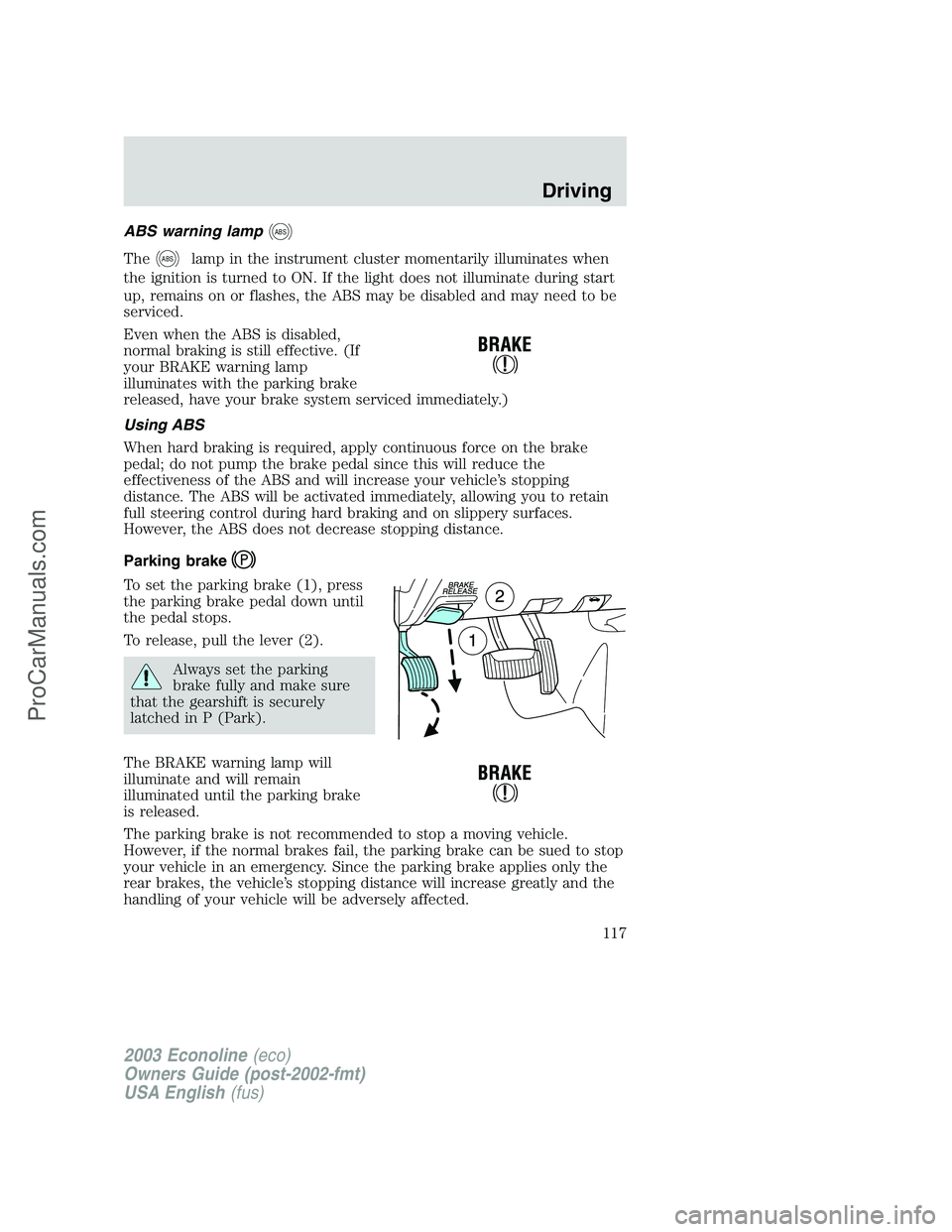
ABS warning lampABS
TheABSlamp in the instrument cluster momentarily illuminates when
the ignition is turned to ON. If the light does not illuminate during start
up, remains on or flashes, the ABS may be disabled and may need to be
serviced.
Even when the ABS is disabled,
normal braking is still effective. (If
your BRAKE warning lamp
illuminates with the parking brake
released, have your brake system serviced immediately.)
Using ABS
When hard braking is required, apply continuous force on the brake
pedal; do not pump the brake pedal since this will reduce the
effectiveness of the ABS and will increase your vehicle’s stopping
distance. The ABS will be activated immediately, allowing you to retain
full steering control during hard braking and on slippery surfaces.
However, the ABS does not decrease stopping distance.
Parking brake
To set the parking brake (1), press
the parking brake pedal down until
the pedal stops.
To release, pull the lever (2).
Always set the parking
brake fully and make sure
that the gearshift is securely
latched in P (Park).
The BRAKE warning lamp will
illuminate and will remain
illuminated until the parking brake
is released.
The parking brake is not recommended to stop a moving vehicle.
However, if the normal brakes fail, the parking brake can be sued to stop
your vehicle in an emergency. Since the parking brake applies only the
rear brakes, the vehicle’s stopping distance will increase greatly and the
handling of your vehicle will be adversely affected.
2003 Econoline(eco)
Owners Guide (post-2002-fmt)
USA English(fus)
Driving
117
ProCarManuals.com
Page 120 of 232
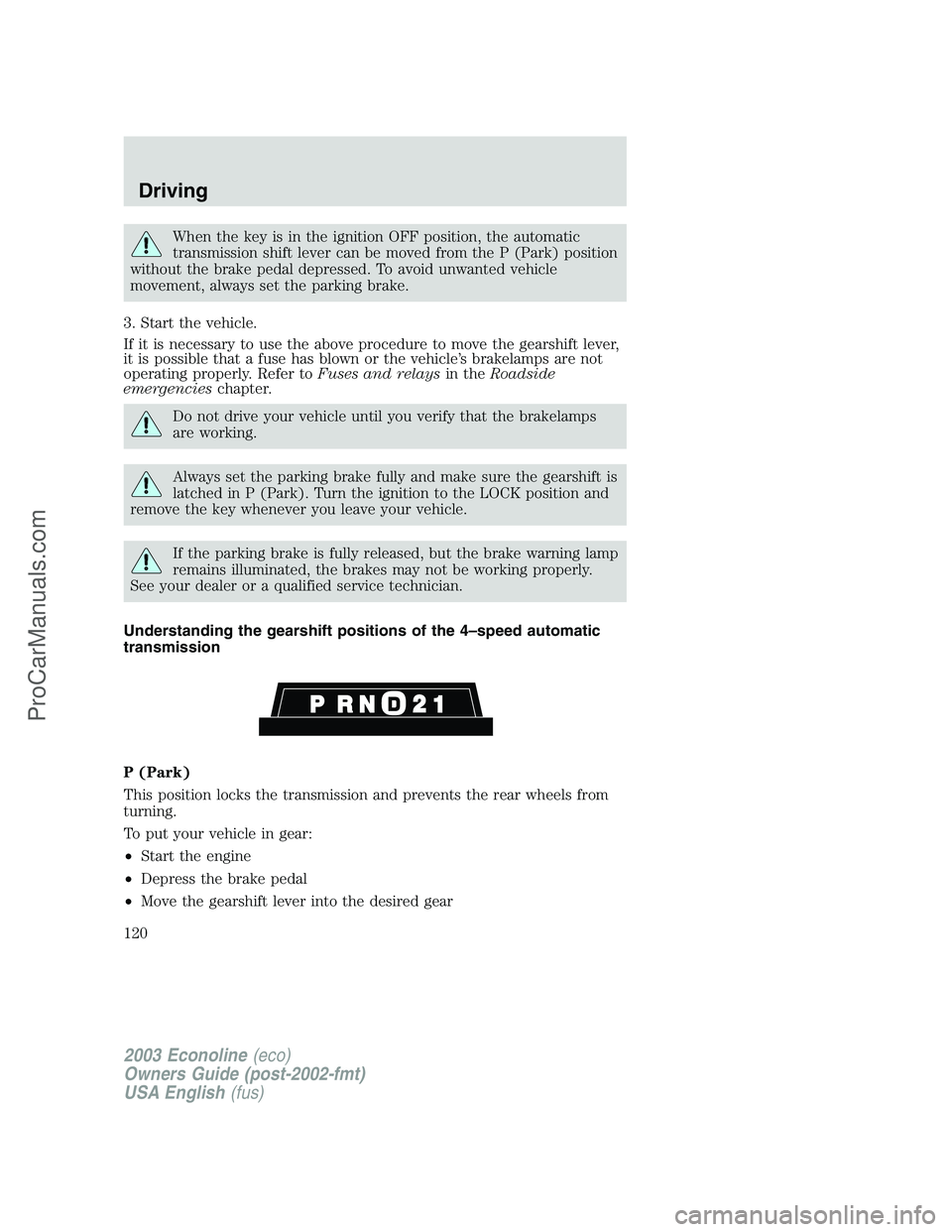
When the key is in the ignition OFF position, the automatic
transmission shift lever can be moved from the P (Park) position
without the brake pedal depressed. To avoid unwanted vehicle
movement, always set the parking brake.
3. Start the vehicle.
If it is necessary to use the above procedure to move the gearshift lever,
it is possible that a fuse has blown or the vehicle’s brakelamps are not
operating properly. Refer toFuses and relaysin theRoadside
emergencieschapter.
Do not drive your vehicle until you verify that the brakelamps
are working.
Always set the parking brake fully and make sure the gearshift is
latched in P (Park). Turn the ignition to the LOCK position and
remove the key whenever you leave your vehicle.
If the parking brake is fully released, but the brake warning lamp
remains illuminated, the brakes may not be working properly.
See your dealer or a qualified service technician.
Understanding the gearshift positions of the 4–speed automatic
transmission
P (Park)
This position locks the transmission and prevents the rear wheels from
turning.
To put your vehicle in gear:
•Start the engine
•Depress the brake pedal
•Move the gearshift lever into the desired gear
2003 Econoline(eco)
Owners Guide (post-2002-fmt)
USA English(fus)
Driving
120
ProCarManuals.com
Page 131 of 232
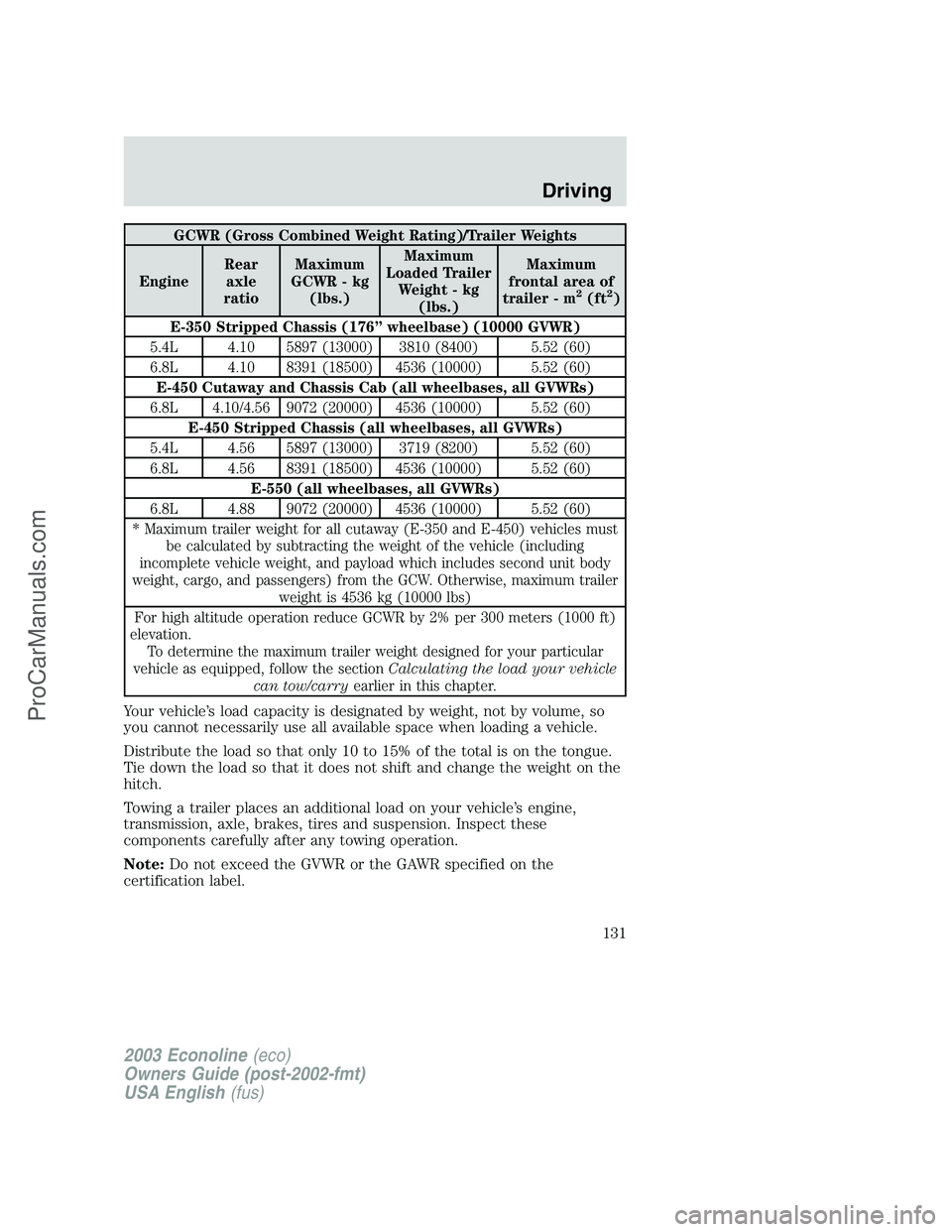
GCWR (Gross Combined Weight Rating)/Trailer Weights
EngineRear
axle
ratioMaximum
GCWR - kg
(lbs.)Maximum
Loaded Trailer
Weight - kg
(lbs.)Maximum
frontal area of
trailer - m
2(ft2)
E-350 Stripped Chassis (176”wheelbase) (10000 GVWR)
5.4L 4.10 5897 (13000) 3810 (8400) 5.52 (60)
6.8L 4.10 8391 (18500) 4536 (10000) 5.52 (60)
E-450 Cutaway and Chassis Cab (all wheelbases, all GVWRs)
6.8L 4.10/4.56 9072 (20000) 4536 (10000) 5.52 (60)
E-450 Stripped Chassis (all wheelbases, all GVWRs)
5.4L 4.56 5897 (13000) 3719 (8200) 5.52 (60)
6.8L 4.56 8391 (18500) 4536 (10000) 5.52 (60)
E-550 (all wheelbases, all GVWRs)
6.8L 4.88 9072 (20000) 4536 (10000) 5.52 (60)
* Maximum trailer weight for all cutaway (E-350 and E-450) vehicles must
be calculated by subtracting the weight of the vehicle (including
incomplete vehicle weight, and payload which includes second unit body
weight, cargo, and passengers) from the GCW. Otherwise, maximum trailer
weight is 4536 kg (10000 lbs)
For high altitude operation reduce GCWR by 2% per 300 meters (1000 ft)
elevation.
To determine the maximum trailer weight designed for your particular
vehicle as equipped, follow the sectionCalculating the load your vehicle
can tow/carryearlier in this chapter.
Your vehicle’s load capacity is designated by weight, not by volume, so
you cannot necessarily use all available space when loading a vehicle.
Distribute the load so that only 10 to 15% of the total is on the tongue.
Tie down the load so that it does not shift and change the weight on the
hitch.
Towing a trailer places an additional load on your vehicle’s engine,
transmission, axle, brakes, tires and suspension. Inspect these
components carefully after any towing operation.
Note:Do not exceed the GVWR or the GAWR specified on the
certification label.
2003 Econoline(eco)
Owners Guide (post-2002-fmt)
USA English(fus)
Driving
131
ProCarManuals.com
Page 133 of 232
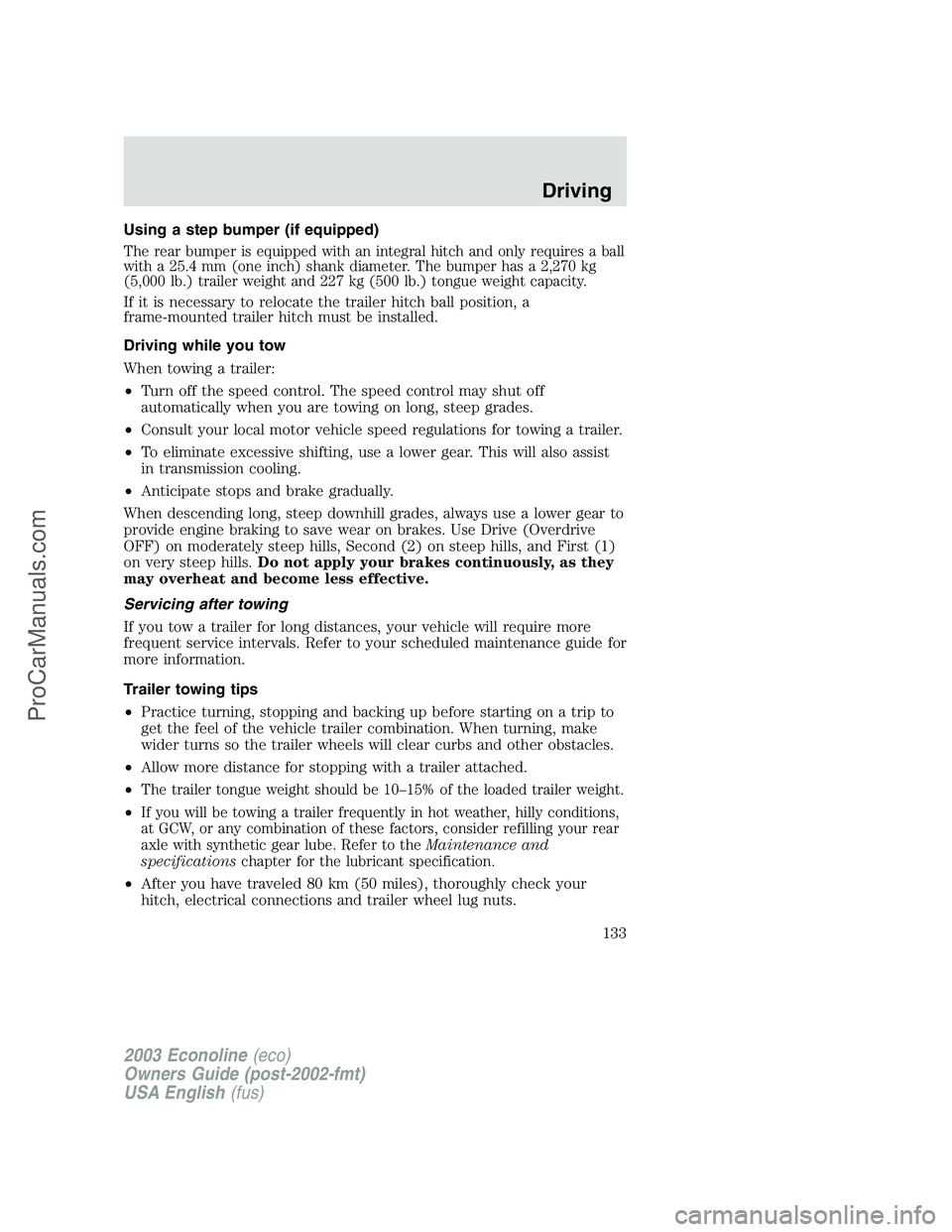
Using a step bumper (if equipped)
The rear bumper is equipped with an integral hitch and only requires a ball
with a 25.4 mm (one inch) shank diameter. The bumper has a 2,270 kg
(5,000 lb.) trailer weight and 227 kg (500 lb.) tongue weight capacity.
If it is necessary to relocate the trailer hitch ball position, a
frame-mounted trailer hitch must be installed.
Driving while you tow
When towing a trailer:
•Turn off the speed control. The speed control may shut off
automatically when you are towing on long, steep grades.
•Consult your local motor vehicle speed regulations for towing a trailer.
•To eliminate excessive shifting, use a lower gear. This will also assist
in transmission cooling.
•Anticipate stops and brake gradually.
When descending long, steep downhill grades, always use a lower gear to
provide engine braking to save wear on brakes. Use Drive (Overdrive
OFF) on moderately steep hills, Second (2) on steep hills, and First (1)
on very steep hills.Do not apply your brakes continuously, as they
may overheat and become less effective.
Servicing after towing
If you tow a trailer for long distances, your vehicle will require more
frequent service intervals. Refer to your scheduled maintenance guide for
more information.
Trailer towing tips
•Practice turning, stopping and backing up before starting on a trip to
get the feel of the vehicle trailer combination. When turning, make
wider turns so the trailer wheels will clear curbs and other obstacles.
•Allow more distance for stopping with a trailer attached.
•
The trailer tongue weight should be 10–15% of the loaded trailer weight.
•If you will be towing a trailer frequently in hot weather, hilly conditions,
at GCW, or any combination of these factors, consider refilling your rear
axle with synthetic gear lube. Refer to theMaintenance and
specificationschapter for the lubricant specification.
•After you have traveled 80 km (50 miles), thoroughly check your
hitch, electrical connections and trailer wheel lug nuts.
2003 Econoline(eco)
Owners Guide (post-2002-fmt)
USA English(fus)
Driving
133
ProCarManuals.com
Page 225 of 232
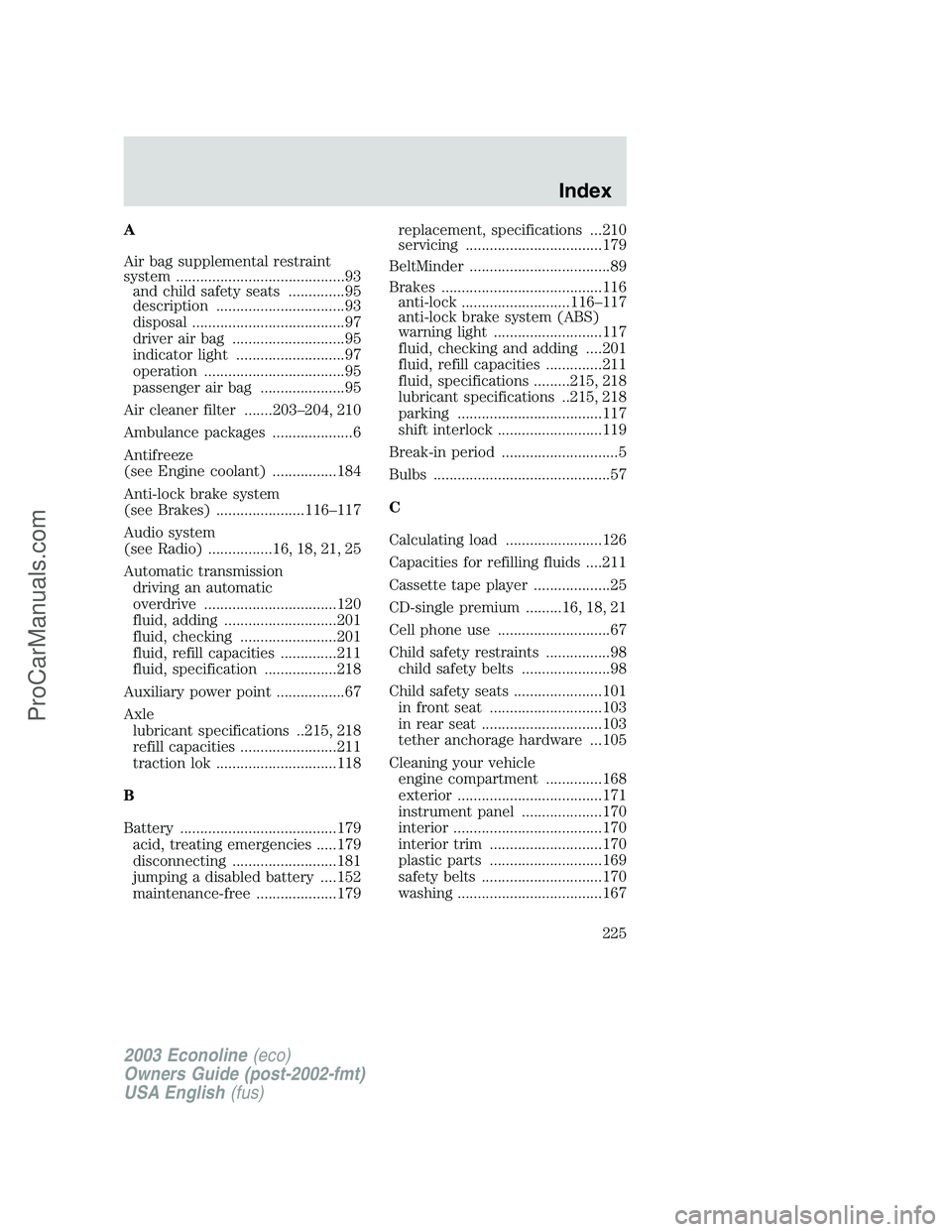
A
Air bag supplemental restraint
system ..........................................93
and child safety seats ..............95
description ................................93
disposal ......................................97
driver air bag ............................95
indicator light ...........................97
operation ...................................95
passenger air bag .....................95
Air cleaner filter .......203–204, 210
Ambulance packages ....................6
Antifreeze
(see Engine coolant) ................184
Anti-lock brake system
(see Brakes) ......................116–117
Audio system
(see Radio) ................16, 18, 21, 25
Automatic transmission
driving an automatic
overdrive .................................120
fluid, adding ............................201
fluid, checking ........................201
fluid, refill capacities ..............211
fluid, specification ..................218
Auxiliary power point .................67
Axle
lubricant specifications ..215, 218
refill capacities ........................211
traction lok ..............................118
B
Battery .......................................179
acid, treating emergencies .....179
disconnecting ..........................181
jumping a disabled battery ....152
maintenance-free ....................179replacement, specifications ...210
servicing ..................................179
BeltMinder ...................................89
Brakes ........................................116
anti-lock ...........................116–117
anti-lock brake system (ABS)
warning light ...........................117
fluid, checking and adding ....201
fluid, refill capacities ..............211
fluid, specifications .........215, 218
lubricant specifications ..215, 218
parking ....................................117
shift interlock ..........................119
Break-in period .............................5
Bulbs ............................................57
C
Calculating load ........................126
Capacities for refilling fluids ....211
Cassette tape player ...................25
CD-single premium .........16, 18, 21
Cell phone use ............................67
Child safety restraints ................98
child safety belts ......................98
Child safety seats ......................101
in front seat ............................103
in rear seat ..............................103
tether anchorage hardware ...105
Cleaning your vehicle
engine compartment ..............168
exterior ....................................171
instrument panel ....................170
interior .....................................170
interior trim ............................170
plastic parts ............................169
safety belts ..............................170
washing ....................................167
2003 Econoline(eco)
Owners Guide (post-2002-fmt)
USA English(fus)
Index
Index
225
ProCarManuals.com